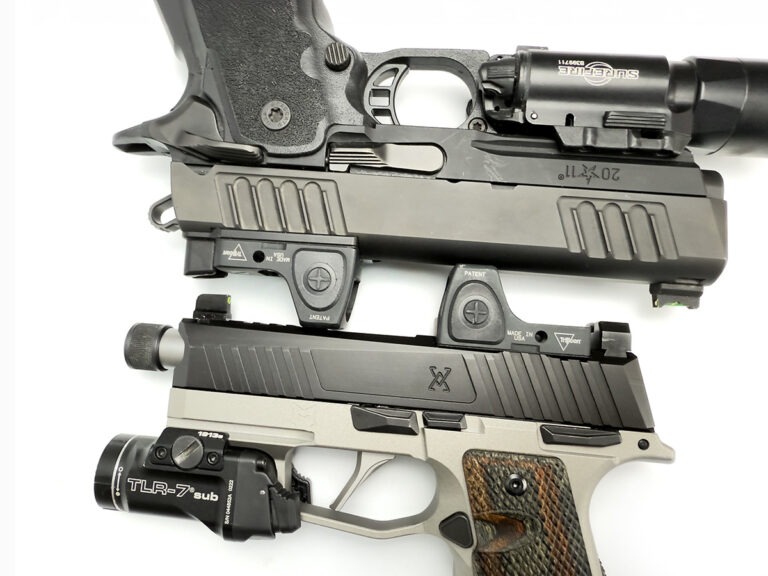
It can get confusing figuring out which optics are compatible with your pistol’s red dot footprint. Here, I explain what goes with what.
The idea of putting reflex or red-dot-style sights on pistols has been around for a while longer than you might imagine. What we call “modern optics cuts” also aren’t exactly new, but they are somewhat modern regarding the fact that miniature optics are a somewhat recent invention.
Today, we have a tremendous number of options when it comes to applying a mini optic to your pistol and, well, there’s also a tremendous amount of confusion when it comes to what works with what.
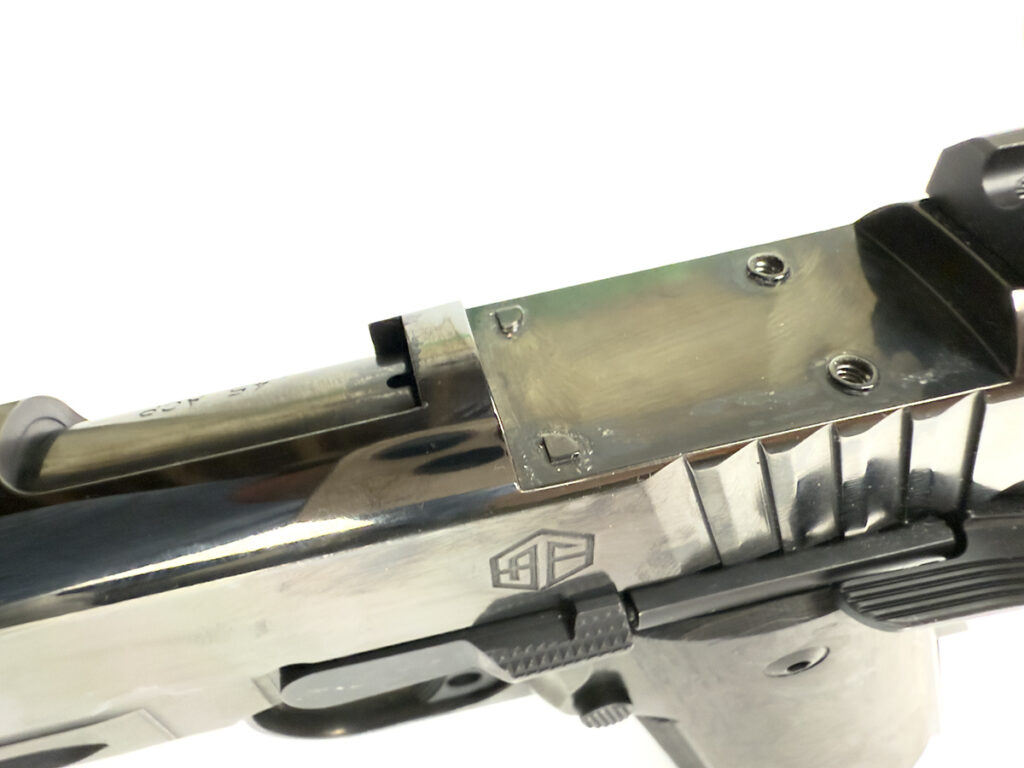
An Abridged (Recent) History of Pistol Red Dots
The old days of mounting optical sights to pistols revolved around the technology of the time, and the first red-dot sights to be brought to market were quite large and meant for mounting on rifles and shotguns. The mounts designed to integrate these optics onto pistols were typically mounted to the frame, not the slide like we see today. These early dot sights were large and took up a good amount of space across the top of the slide. These guns were typically used in a variety of speed and accuracy competitions and referred to as “race guns” by many in the scene. An interesting note is that it was more common to find full-size hunting revolvers with these big red-dots than semi-autos for a while, which has come full circle with several revolver makers now adding modern optic cuts to their products.
There was really no movement in the market for red dots for a while … until the early years of the War on Terror, and then things started to take off. By this time, the Trijicon ACOG and Aimpoint dot sights were commonplace, and the general public had taken notice as well. Mini-dot sights did, in fact, exist at this time, circa 2007. The Doctor red-dot sight was among the first to be piggybacked to the ACOG, followed shortly afterward by the early Trijicon Red Dot Sight. Very shortly afterward the big (little) one hit: the first Trijicon RMR, or Ruggedized Miniature Reflex sight, was introduced.
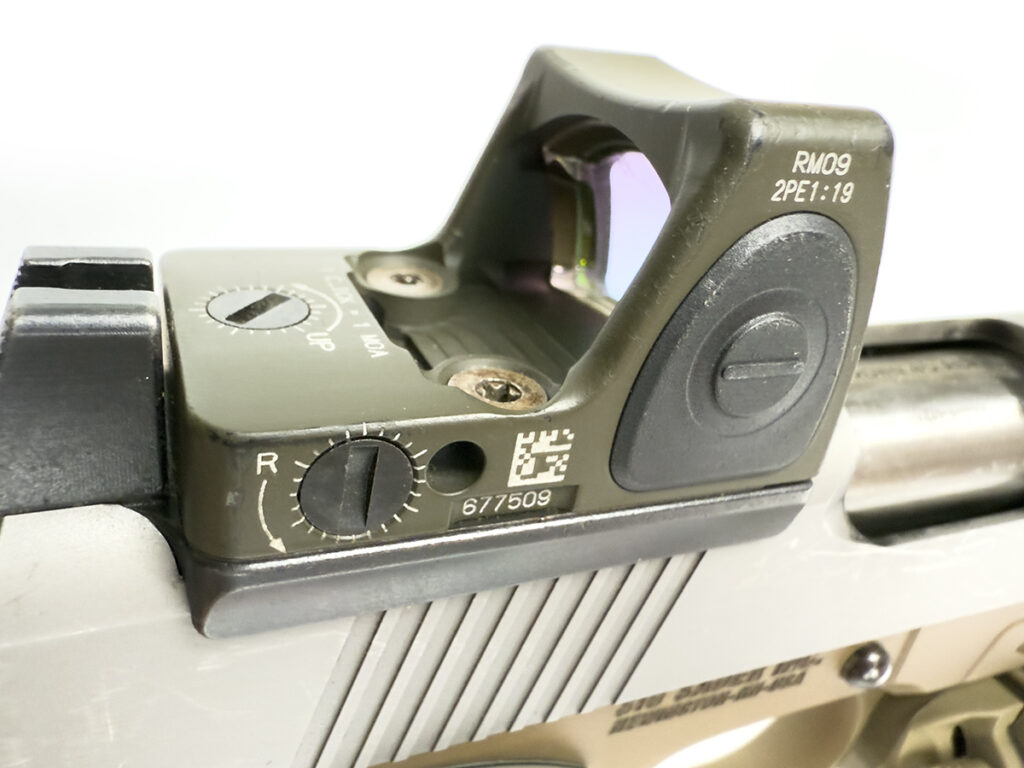
When these came out in 2009, it was big news—but the potential was far from being realized as we know it today. The original generation of RMR sights were very well designed and rugged; however, there were some issues with the very first attempts to mount them to pistols. Trijicon’s subsequent models addressed the small issues and, since then, there have been very few issues.
In my research for this topic, I was unable to find just who was the first to mill a pistol slide to take an RMR. There are a lot of people claiming to have been the first to do this, but the earliest examples of this didn’t start appearing until several years after the introduction of the RMR itself. It seemed that it was Glock pistols that were the usual host, but there unfortunately isn’t much information surrounding this particular topic due to the fact that the majority of customizations were done as one-offs and not standardized by any definition.
The “Roland Special” began to gain traction as an early version of the optically equipped fighting pistol: It was basically a Glock-type pistol with a slide modified to accept an RMR, a compensator mounted on a threaded barrel, a light, and typically a magazine well funnel. It was something of a combination of fighting gun and competition pistol, but it was still just a loose concept and not yet fully accepted by major manufacturers. This concept was popular in the mid 2010s.
The debate started shortly after, adding rhetoric as to whether this concept was actually feasible. I started shooting slide-mounted red-dots in 2015, and there wasn’t a lot available, with the average mounting solution being a plate that mounted into the dovetail of Glock pistols. Initially, I wasn’t impressed and gave up on the concept for a while, instead opting for better iron sights and lights on my pistols.
I revisited this in 2018—after the concept was reaching maturity—and built the custom 1911 that has graced these pages in my photography. It has a slide that was made to accept a Trijicon-integrated RMR mount that includes an integrated rear sight for co-witness. At the time I built this pistol, the RMR was still very much the leader in a somewhat cornered market; the other companies had not quite managed to catch up.
But that wouldn’t last long.
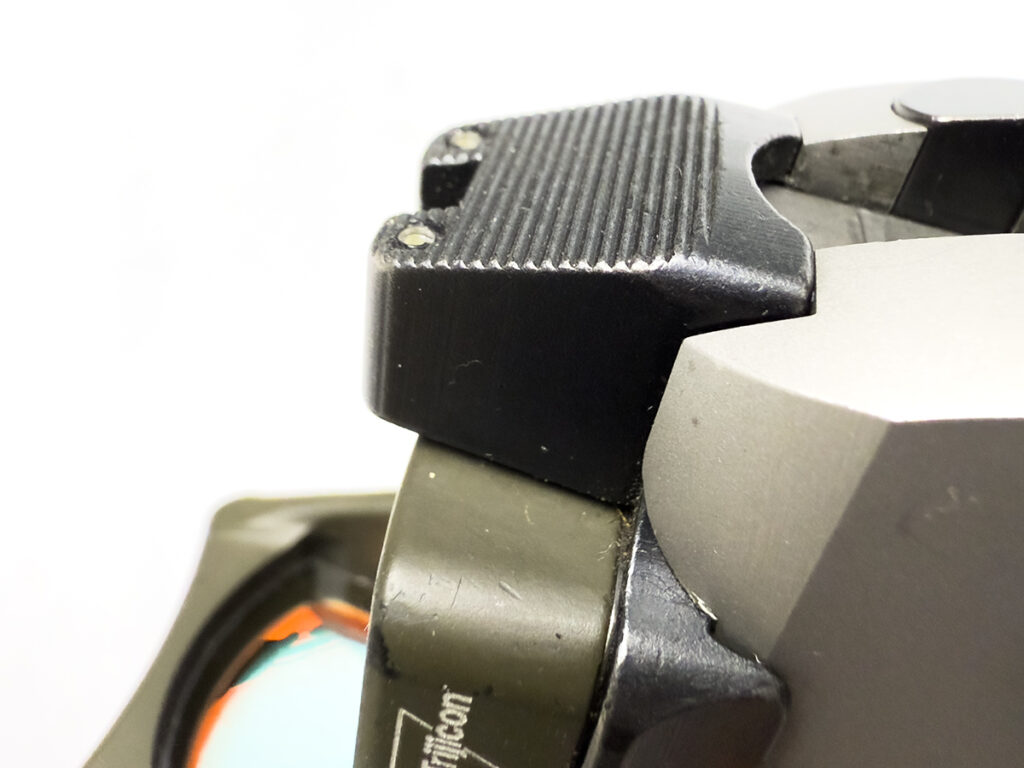
The 2020s have seen virtually every pistol company releasing models with optic cuts, and there are a large number of available footprints for these due to an ever-growing number of new mini-dot style optics. There are a great many available now, and this has led to a certain degree of confusion in the market, especially for consumers.
Following the Footprints
The first question I get in any conversion is along the lines of, “How do you pick a footprint?”
Well, in general, the issue comes down to a very specific set of criteria that you will want to individually research, and a lot of this depends on what type of gun you have or, alternatively, what model of sight you want to use. I use the RMR on many pistols, but I also use the RMRcc, the smaller, slimmer carry version. These footprints, despite both being Trijicon RMR sights, are not interchangeable.
The full-size 1911 with a 1-MOA dot is great for hunting out to 50 yards, which is what I do with it. The larger RMR is nice for precision and field-of-view. The RMRcc is smaller and has a larger dot, so the dot itself takes up more of the optical window, making it great for fast shooting at close range. I use this sight on my Staccato C and custom P365 from True Precision. I would need to use something that utilizes the same footprint if I wanted to change the RMR on my 1911, since it has a fixed base on the slide. The Trijicon RCR and SRO would work for this, for instance.
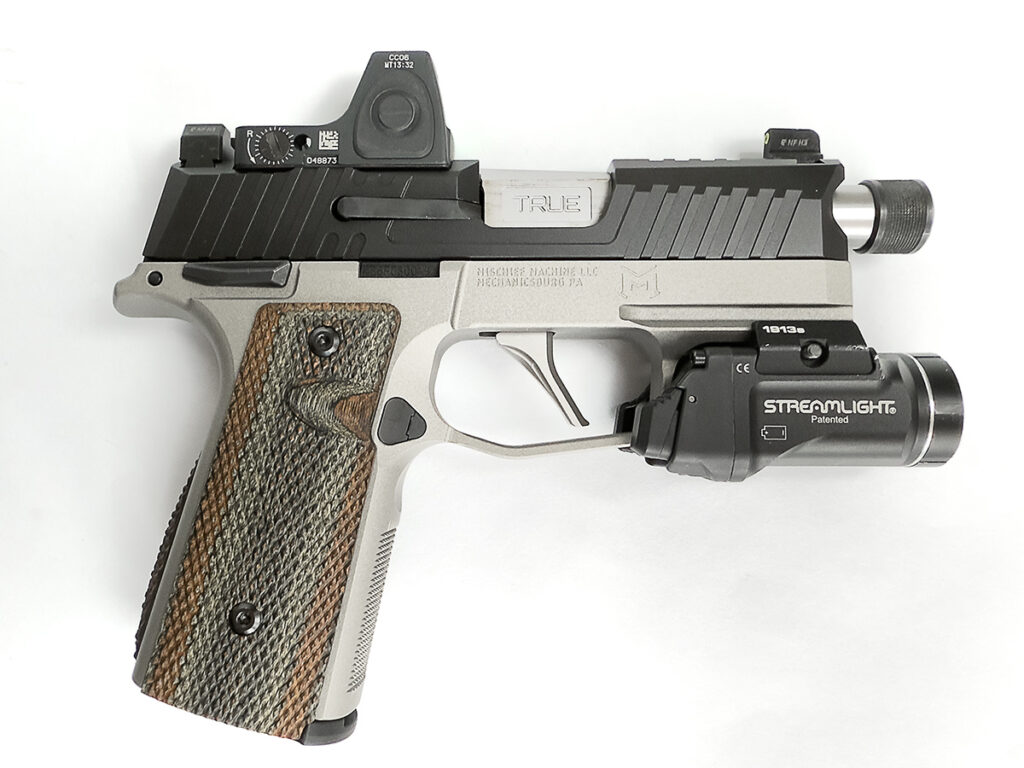
However, it’s more convoluted today with all the available options … and also simpler. You might not be able to mount a specific dot to a specific gun, but most pistols being made today can accept at least some form of dot.
The next question I get is, “How many different optics footprints are there?”
Well, this requires a long answer. We have not just the “footprint,” meaning the physical cut dimensions that determines the size of optic that can be mounted, but we also have a variety of adapter plates, plus proprietary interfaces. The list is growing constantly.
The main difference between a true footprint and an adapter plate is the permanent nature of the lugs. Each red-dot footprint has a different lug and mounting screw spacing. The lugs interact with the body of the sight to prevent it from moving, just like the recoil lug on the action of a bolt gun that interfaces with the stock.
If, for instance, you have your slide machined for an RMRcc, it will only be that footprint. Many pistols come with adapter plates that get sandwiched between the sight and slide. The slide is machined to receive only a certain type of adapter plate, so as long as you have these adapters you can use any brand of optic that there is a plate for.
So, in theory, this discussion is so broad that the answer is “almost limitless,” depending on what system you choose.
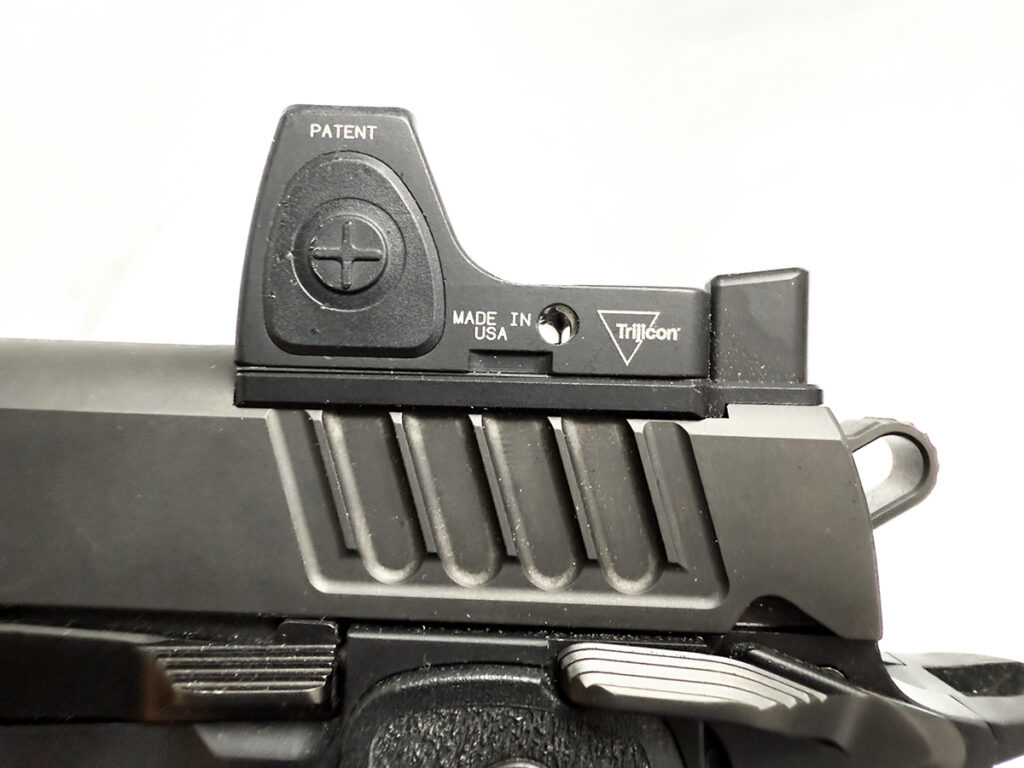
In general, there are some optic footprints that are cross-compatible with a number of brands, and I use a number of them. Now, this is not a comprehensive list because many companies are coming out with new designs as I type this, but nearly every pistol maker is offering optic cuts. A short list has all the usual suspects: Staccato, Glock, Colt, S&W, Ruger, Sig Sauer, Beretta, Springfield Armory, Walther, HK, virtually every 2011 maker, Taurus, FN, custom makers like Ed Brown, Dan Wesson, Nighthawk—and the list goes on.
There is also an expanding market of sights from companies like Vortex, Trijicon, Leupold, Doctor, Holosun, Riton, Swampfox, Bushnell, Hawke, Burris, Aimpoint and more. Again, this is a rapidly expanding market and, by the time you read these words, there will undoubtedly be more on the market than we’re there yesterday.
The general list of footprints encompasses the RMSC, RMS, RMR, RMRcc, DPP, Glock MOS (adapter plate system), Doctor, ACRO, Holosun K, EPS, 509T and more. The most popular footprints as of today are the RMSC, RMR and DPP. Of note is that many of these companies make sights that are cross-compatible with various mounts, such the Vortex Defender using the DPP (Leupold DeltaPoint Pro) footprint. Not all companies have a specific design that has produced its own footprint that bears its name, such as the RMR footprint. You can use other optics on the RMR footprint, but the RMR can only work on its namesake.
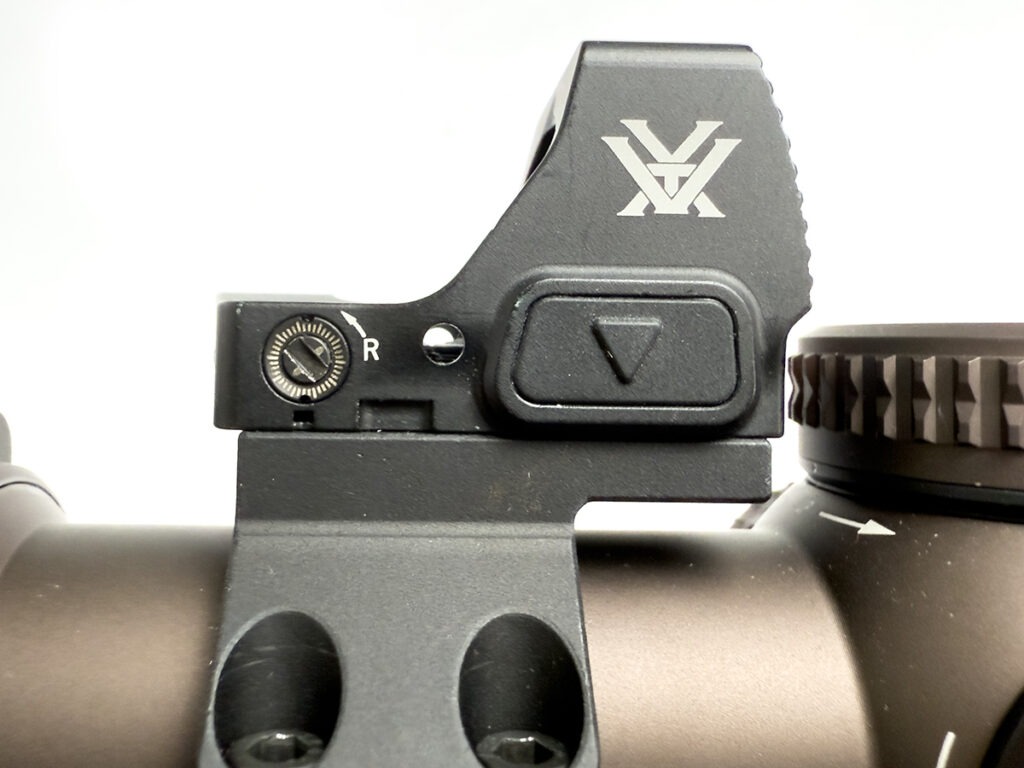
Alternate Optics Uses
The micro-dot world started piggybacking to rifle optics … and then migrated to pistols. Now that this technology is growing and more common, modern micro-dots are making their way back to rifles and carbines, and even shotguns.
The LPVO class of optics has dominated the game for the past decade, and they have gradually become more advanced for their size, as demonstrated by the Vortex Razor 1-10x in this article’s photography. The idea was to hybridize the singular riflescope to allow it to function as a sort of reflex sight while still being a long-range precision item, the Razor here is able to tackle everything from zero to past 1,000 yards on a lightweight carbine.
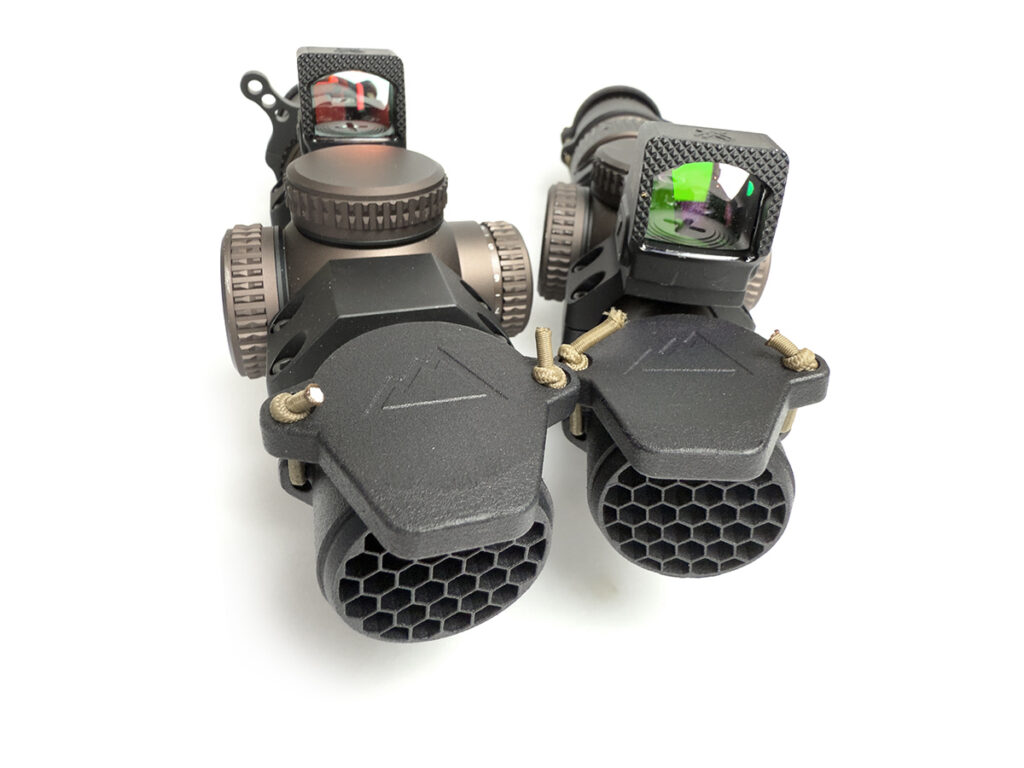
However, for very close range engagements, it still requires you to get low on the riflestock and look directly through it. I use American Defense Manufacturing mounts on all my rifles, and a huge benefit is that they make rig caps that have machined-in optic footprints. The Vortex Defender line simply mounts to the scope mount and offers fast handling without sacrificing anything the Razor has to offer. I really enjoy this setup; it’s such a no-brainer for that surprise game animal walking in closer than you thought.
Red-Dot Zeroing and Accuracy
The adage “aim small, miss small” comes heavily into play with pistol optics. As I mentioned earlier, I replaced the first-gen RMR on my 1911 with a modern one; this time with a 1 MOA dot. The first optic I had on there was the large 12.9 MOA reticle, and it was fine for close range. But for hunting use, the 1 MOA makes a massive difference.
Now, this is a fine dot to pick up. Most people have settled on a 3-8MOA type, but with deer being a fair challenge for a .45 ACP, I opted for a much finer dot. I zero this pistol point blank for 50 yards using my favorite .45 ACP load, the 220-grain Hornady Critical Duty. The bullet flight path never leaves the heart of the deer out to this distance.
I also find it a useful zero for subsonic loads. The larger the dot, the more important your knowledge is of where your bullet is impacting inside the dot. There are some big dots out there, and they are easier to see but offer a wider range of error.
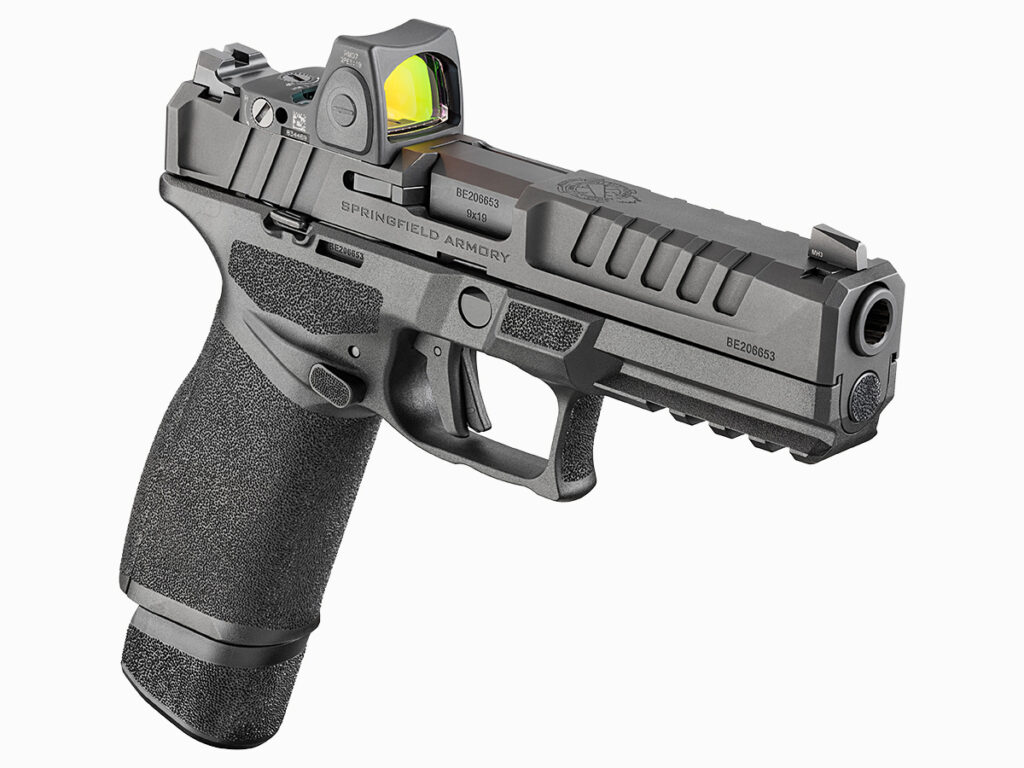
I zero most of my self-defense pistols using the RMRcc at 15 yards to impact in the center of the dot. I also take the time to zero my iron sights through the optic, not just treat them as a vestigial organ to the optic. You’ll find that the zero of your irons might be the best range to zero your dot for consistency.
There is discussion of what the best distance to zero your pistol is, but assuming we’re talking 9mm as most people are using these days, the 15-yard zero is pretty good for general use. I don’t like the 10-yard zero: it’s just very close and can introduce a lot of error in bullet impact as you back away. The 20-yard zero is much better, and you can shoot pretty flat with it. You can usually stay on an IDPA silhouette at 75 yards or so. Aiming for the head at 100 yards can usually result in hits.
The further you zero the gun, you do need to be aware of the fact that you’ll be low at closer ranges, not by much … but enough to know you’ll probably be impacting at the bottom of your dot or, even optical window, assuming you’re shooting a 3 MOA or similar. So, you’d need to hold slightly high if you were trying to do a pistol match for close targets, but you’d be at an advantage on the long pokes.
The decision is up to you: It’s not hard to test out what is best for you and your setup.
Red Dot Redux
Optically equipped pistols are here to stay. There are serious advantages to them—and also some downsides—but overall, the technology is maturing at a good rate. As far as footprints go, I stand by the prediction I made on these pages years ago that eventually we’d end up with a few standards after more companies jump in to support them.
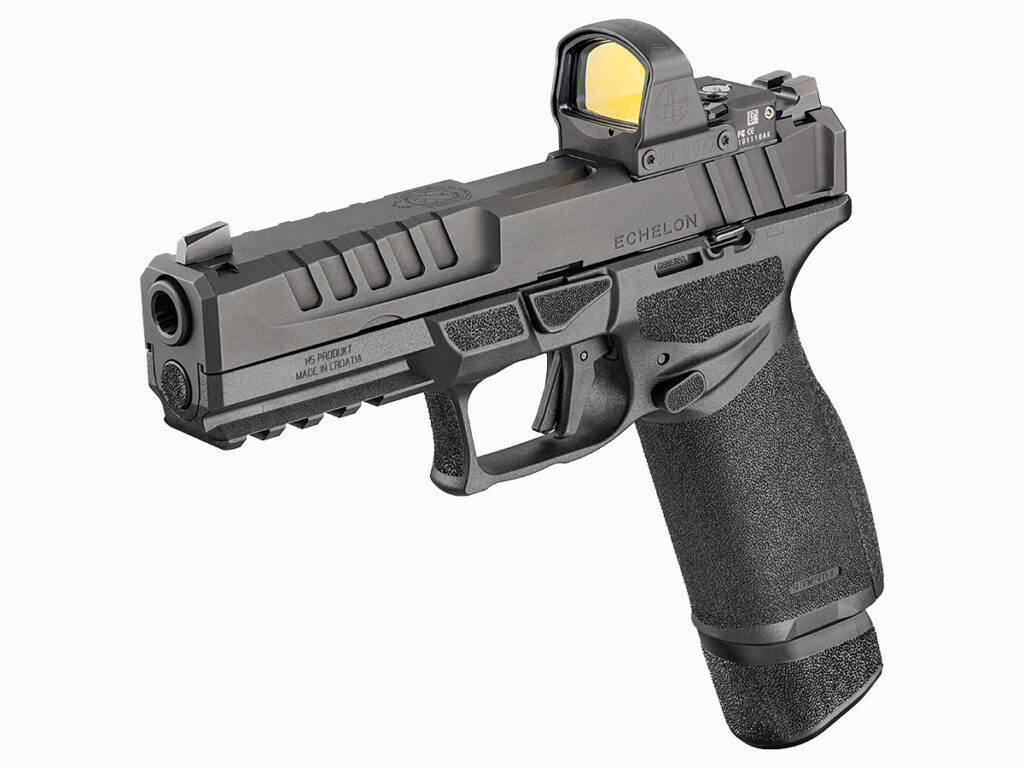
I think the RMSC, RMR and DPP footprints will end up being the de facto standards for the next decade, but I wouldn’t be surprised if we end up with even more footprints. After all, standardization often breeds its own innovation.
The future is going to be exciting … that much is for sure.
Editor's Note: This article originally appeared in the November 2025 issue of Gun Digest the Magazine.
More On Pistol Red Dots:
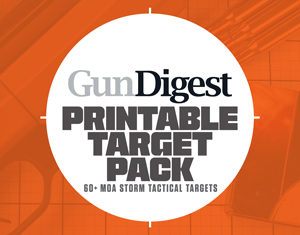
Next Step: Get your FREE Printable Target Pack
Enhance your shooting precision with our 62 MOA Targets, perfect for rifles and handguns. Crafted in collaboration with Storm Tactical for accuracy and versatility.
Subscribe to the Gun Digest email newsletter and get your downloadable target pack sent straight to your inbox. Stay updated with the latest firearms info in the industry.

![Best Concealed Carry Guns In 2025 [Field Tested] Wilson Combat EDC X9S 1](https://gundigest.com/wp-content/uploads/Wilson-Combat-EDC-X9S-1-324x160.jpg)


![Best 9mm Carbine: Affordable PCCs [Tested] Ruger Carbine Shooting](https://gundigest.com/wp-content/uploads/Ruger-Carbine-Shooting-100x70.jpg)
![Best AR-15: Top Options Available Today [Field Tested] Harrington and Richardson PSA XM177E2 feature](https://gundigest.com/wp-content/uploads/Harrington-and-Richardson-PSA-XM177E2-feature-100x70.jpg)
